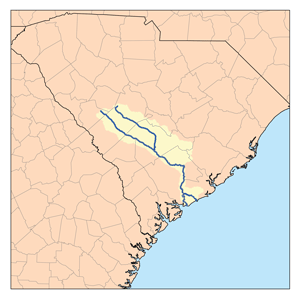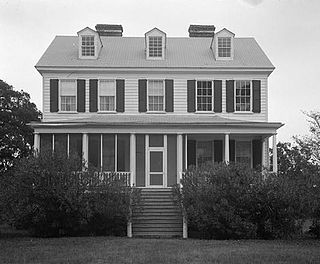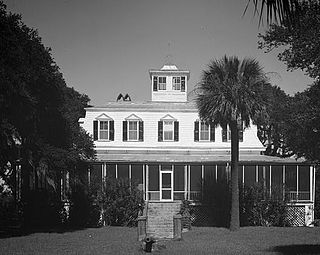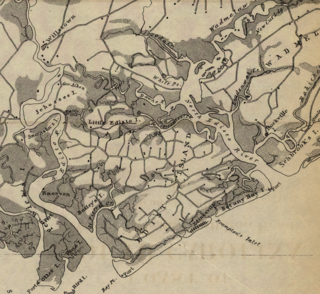
Edisto Beach is a town in Colleton County, South Carolina, United States. Edisto Beach's population was 414 as of the 2010 census, down from 641 in 2000. The town limits include only the developed coastal area of Edisto Island within Colleton County, while the majority of the island consists of unincorporated land in Charleston County. Due to its status as a bedroom community, Edisto Beach is among the most affluent communities in the state.

The Edisto River is one of the longest free-flowing blackwater rivers in North America, flowing over 250 meandering miles from its sources in Saluda and Edgefield counties, to its Atlantic Ocean mouth at Edisto Beach, South Carolina. It rises in two main tributaries from springs under the Sandhills region of West Central South Carolina, just to the south of the Piedmont Fall Line. It is the longest and largest river system completely contained by the borders of South Carolina. Its name comes from the Edisto subtribe of the Cusabo Indians.

Whitemarsh Benjamin Seabrook was the 63rd Governor of South Carolina from 1848 to 1850.

Edisto Beach State Park is located on the coast of South Carolina, 50 miles south of Charleston, near the town of Edisto Beach in Colleton County.

The William Seabrook House, also known as the Seabrook is a plantation house built about 1810 on Edisto Island, South Carolina, United States, southwest of Charleston. It is located off Steamboat Landing Road Extension close to Steamboat Creek about 0.7 mi (1.1 km) from Steam Boat Landing. It was named to the National Register of Historic Places on May 6, 1971.

The Ashepoo, Combahee and Edisto Basin is one of the largest undeveloped estuaries along the Atlantic Coast of the United States. Located primarily in Colleton, Charleston, and Beaufort counties in South Carolina, the Ashepoo, Combahee and South Edisto rivers combine into the larger St. Helena Sound and drain a significant portion of the Lowcountry region. The 350,000 acres (1,400 km2) area is known for its natural environment and the preservation of its marshes, wetlands, hardwood forests, and riverine systems and the fauna that occupy the area.

Edisto Island Baptist Church is an historic African-American Baptist church located at Edisto Island, Charleston County, South Carolina. It was built in 1818, and is a two-story church that is sheathed in beaded weatherboard and has a medium pitched gable roof. An addition doubling the size of the church was completed about 1865, and a two-story pedimented portico was added in 1880.

Edisto Island Presbyterian Church is a historic Presbyterian church on Edisto Island, South Carolina.

Presbyterian Manse is a historic wooden building on Edisto Island, South Carolina. This wo-and-a-half story building was built in 1790 and added to the National Register of Historic Places on May 14, 1971. The building which land was donated by Henry Bowers was constructed for the minister of the church.

South Carolina Highway 174 (SC 174) is a 25 3⁄4-mile (41.4 km) state highway, connecting Edisto Island with the mainland of South Carolina. The highway was designated a South Carolina scenic byway in 1988. In 2009, the U.S. Department of Transportation declared that a 17-mile (27 km) stretch of SC 174 on Edisto Island would be designated as a National Scenic Byway.

Botany Bay Plantation Heritage Preserve/Wildlife Management Area is a state preserve on Edisto Island, South Carolina.

Frogmore is a plantation house on Edisto Island, South Carolina, built by Dr. Edward Mitchell of Waccamaw, about 1820 when he married Elizabeth Baynard of Edisto Island.

The Hutchinson House is the oldest identified house on Edisto Island, South Carolina associated with the black community after the American Civil War. It was the residence of Henry Hutchinson, a freed slave. Following the Civil War, Jim Hutchinson worked to assemble groups of freed blacks who would collectively purchase land on Edisto Island. Each contributor then received a fractional interest in the lands acquired. Jim Hutchinson's children built their own homes and farms on the land Jim had acquired. One of his children was Henry Hutchinson. Henry Hutchinson's house is the only one remaining. Henry Hutchinson is said to have built the house at the time of his marriage to Rosa Swinton in 1885 and resided here until his death in 1940.

Prospect Hill is an historic plantation house in Edisto Island, South Carolina.

Windsor Plantation is a historic house on Russell Creek on Edisto Island, South Carolina.

Cassina Point was built in 1847 for Carolina Lafayette Seabrook and her husband, James Hopkinson. Carolina Seabrook was the daughter of wealthy Edisto Island planter William Seabrook. William Seabrook had hosted the General Lafayette in 1825 at his nearby home at the time of Carolina's birth. Seabrook gave Lafayette the honor of naming the newborn child, and the general selected Carolina and Lafayette. When Carolina Seabrook married James Hopkinson, they built Cassina Point on the land given to them by William Seabrook.

Deveaux Bank is a horseshoe-shaped sand spit island encompassing a 215-acre (87-hectare) bird sanctuary at the mouth of the North Edisto River in Charleston County, South Carolina. It is located on the Atlantic Coast between Edisto Island, South Carolina and Seabrook Island, South Carolina. Its average elevation is three feet. It has approximately 2.75 miles of sandy beaches on three sides and a tidal lagoon on the side facing the mainland.

Sunnyside, also known as the Townsend Mikell House, is a historic plantation house located at Edisto Island, Charleston County, South Carolina. The main house was built about 1875, and is a 1 1/2-story, rectangular, frame, weatherboard-clad residence. It features a mansard roof topped by a cupola and one-story, hipped roof wraparound porch. Also on the property are the tabby foundation of a cotton gin; two small, rectangular, one-story, gable roof, weatherboard-clad outbuildings; a 1 1/2-story barn; and the Sunnyside Plantation Foreman's House. The Foreman's House is a two-story, weatherboard-clad, frame residence built about 1867.

Edisto Island during the American Civil War was the location of a number of minor engagements and for a time of a large colony of African-American escaped former slaves during the American Civil War (1861–1865). Edisto Island was largely abandoned by planters in November 1861 and in December 1861, escaped slaves began setting up their own refugee camps there. In January 1862, armed African Americans from the island and Confederate forces clashed and a Confederate raid in reprisal killed a small number of unarmed African Americans. In February, Union forces were stationed on the island to develop it as a staging area for future campaigns against Charleston, twenty-five miles away, as well as to protect the colony, which would eventually number thousands of African Americans. As Union forces took control of the island, a number of skirmishes occurred, but Confederates withdrew. In June, most of the Union troops left the island in a campaign, which culminated in the Battle of Secessionville. In July, the remaining troops withdrew, and the colony was removed to St. Helena Island. For the rest of the war, a small number of escaped slaves and plantation owners remained and farmed the island, but it was largely abandoned. Near the end of the war, the island was again used as a location of colonies of freed slaves.
















